Lurgan, Co. Armagh
Lurgan Poor Law Union was formed on the 16th January 1839, and covered an area of 125 square miles. Its operation was overseen by an elected Board of Guardians, 25 in number, representing its 19 electoral divisions as listed below (figures in brackets indicate numbers of Guardians if more than one):
Co. Armagh:
Breagh, Brownlow's Derry, Carrowbrack, Drumcree, Kernan, Lurgan (2), Montiaghs, Portadown (3), Tartaraghan (2).
Co. Armagh and Co. Down:
Cornakinegar.
Co. Down:
Ballyleny, Donaghcloney, Magheralin, Moira (2), Tullylish (2), Waringstown.
Co. Antrim:
Aghagallon, Aghalee, Ballinderry.
The Board also included 4 ex officio Guardians, making a total of 29. The Guardians met each week at 11am on Thursday.
The population falling within the union at the 1831 census had been 62,259 with divisions ranging in size from Aghalee (population 1,411) to Lurgan itself (5,615).
The new workhouse, built in 1840, was designed by George Wilkinson. It occupied a six-acre site to the south-west of Lurgan and could accommodate 800 inmates. The cost of the building was £8,581 plus £1,319 for fixtures and fittings etc. It was declared fit for the admission of paupers on 1st January 1841, and admitted its first inmates seven weeks later on the 22nd February 1841. The site location and layout are shown on the 1907 map below.
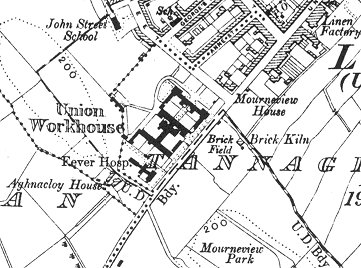
Lurgan workhouse site, 1907.
The buildings followed Wilkinson's typical layout. An entrance and administrative block at the north-east contained a porter's room and waiting room at the centre with the Guardians' board room on the first floor above. Side wings ran back from the entrance block towards each end of the main accommodation block which had the Master's quarters at the centre, and male and female wings to each side.
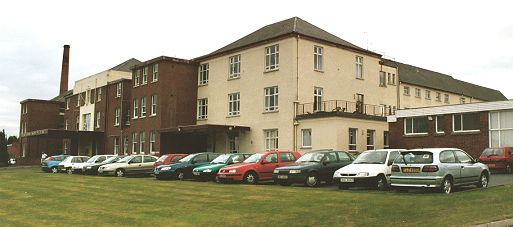
Lurgan much altered entrance block from the north, 2003.
© Peter Higginbotham.
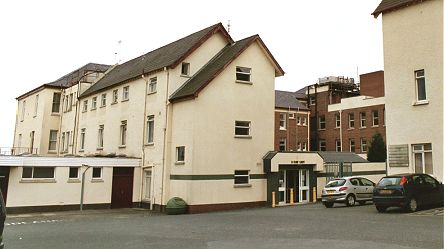
Lurgan rear of entrance block from the west, 2003.
© Peter Higginbotham.
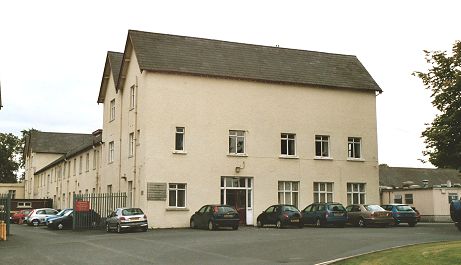
Lurgan main block from the north, 2003.
© Peter Higginbotham.
At the rear, a range of single-storey utility rooms such as bakehouse and washhouse connected through to the infirmary and idiots' wards via a central spine containing the chapel and dining-hall.
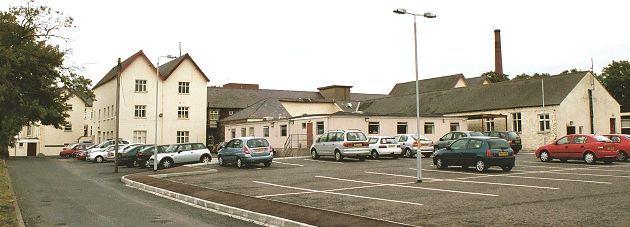
Lurgan rear of main block from the west, 2003.
© Peter Higginbotham.
During the famine in the mid-1840s, sheds were enclosed and new ones erected to accommodate an additional 1200 inmates. A 40-bed fever hospital was erected at the south of the workhouse. A 50-bed extension was soon added, with temporary sheds erected for a further 300 fever patients. The dead were buried in an adjacent graveyard near to the well that supplied the workhouse water.
At the 1901 census, the population of the Union was 53,718 with 18 officials and 403 inmates in the workhouse.
In 1929, the workhouse became Lurgan and Portadown District Hospital, later Lurgan Hospital. Much of the original buildings have now been demolished. The main and chapel blocks survive, with parts of the entrance block incorporated into the present hospital frontage.
The Lurgan Workhouse Mural
In April-May 2006, young residents of Lurgan's Mourneview and Grey Estates, in partnership with Craigavon & Banbridge Community HSS Trust, came together with Caroline Jeffrey, a freelance artist from Belfast's Play Resource, to paint a mural on the flats in Russell Drive in memory of the people who lived, worked, and died in Lurgan Workhouse. Some images of this moving work are shown below.
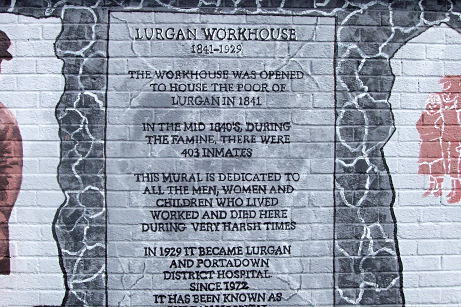
Lurgan workhouse mural, 2006.
Courtesy of Marie Austin.
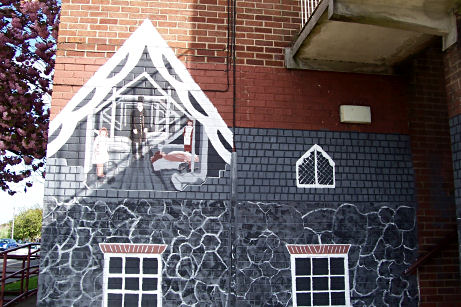
Lurgan workhouse mural, 2006.
Courtesy of Marie Austin.
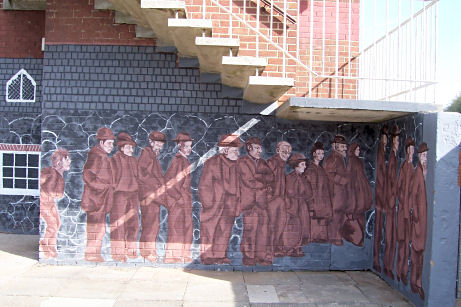
Lurgan workhouse mural, 2006.
Courtesy of Marie Austin.
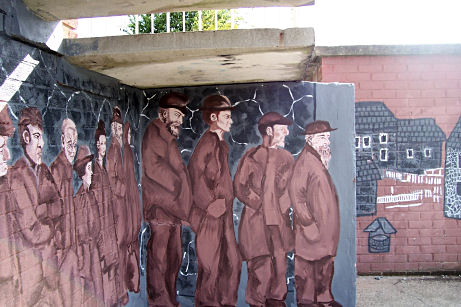
Lurgan workhouse mural, 2006.
Courtesy of Marie Austin.
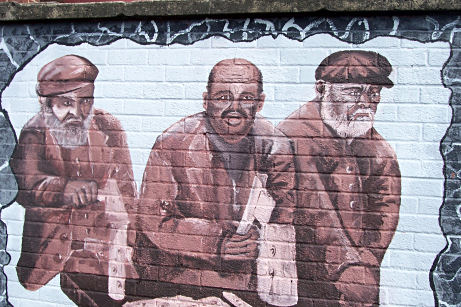
Lurgan workhouse mural, 2006.
Courtesy of Marie Austin.
Records
Note: many repositories impose a closure period of up to 100 years for records identifying individuals. Before travelling a long distance, always check that the records you want to consult will be available.
- Public Record Office of Northern Ireland, 2 Titanic Boulevard, Titanic Quarter, Belfast BT3 9HQ. Holdings include: Guardians' minutes (Feb 1839 - Sep 1948); Indoor register (Feb 1841 - Sep 1949); Admissions and discharges (1927-47); Register of persons receiving infants for reward (1909-30); etc.
Bibliography
- The Workhouses of Ulster by Michael H Gould, 1983.
- The Workhouses of Ireland by John O'Connor (Anvil Books, 1995)
Links
- None.
Unless otherwise indicated, this page () is copyright Peter Higginbotham. Contents may not be reproduced without permission.


